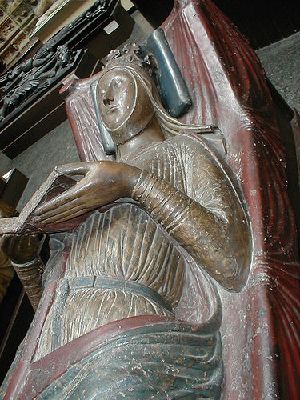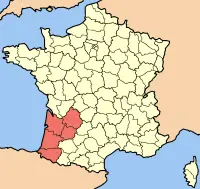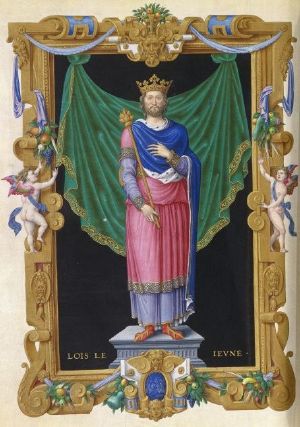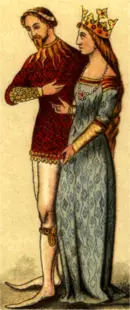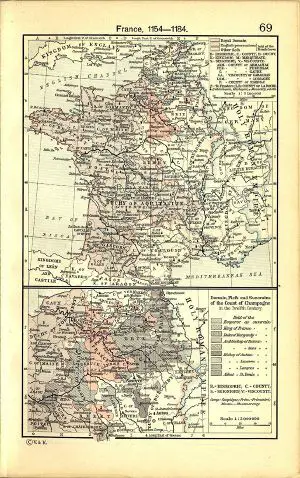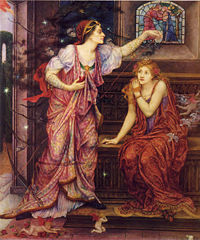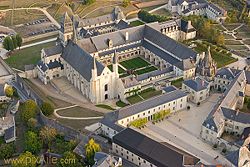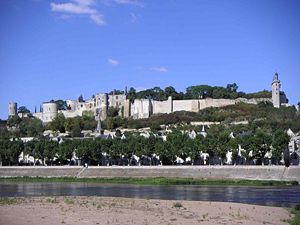Eleanor of Aquitaine
Eleanor of Aquitaine, Duchess of Aquitaine and Gascony and Countess of Poitou (c. 1124 –April 1, 1204) was one of the most powerful women in Europe during the High Middle Ages. She was Queen consort of both France and England in turn and the mother of both English Kings Richard I and John. She was one of the first women to take up the cross and go on crusade. She inspired and led her vassals to go with King Louis VII, her husband, on the Second Crusade in 1147-1148.
Her contemporaries included Hildegard of Bingen, Heloise, (Peter Abelard's wife), Marie of France, and Claire of Assisi. Eleanor was considered one of the greatest women in her own time. In the period of the growth of Courtly Love, she enjoyed fame for her beauty and character, troubadours wrote songs about her, "If all the world were mine from the seashore to the Rhine, that price were not too high to have England's Queen lie close in my arms,"[1] and shaped historical events right up until her death.
Early life
Eleanor was raised in the court of her flamboyant, troubadour grandfather, William IX, who had been excommunicated due to his "kidnapping" of his lover, Dangereuse, from her husband, the Viscount of Châtellerault and living openly with her while William himself was still married to Philippa, mother of Eleanor's father. The court of William IX at Poitou, considered the center of culture at that time, was filled with song, the culture of Courtly Love and abundance, as Aquitaine was the richest duchy in the south of France. William IX was very popular with his people despite his free-thinking lifestyle. In Aquitaine women were allowed a voice and even accepted as rulers as exhibited during the times when Eleanor lived in the region.
The oldest of three children, Eleanor's father was William X, Duke of Aquitaine, and her mother was Aenor de Châtellerault, the daughter of Aimeric I, Vicomte of Châtellerault. Eleanor was named after her mother and called Aliénor, which means the other Aenor.
Inheritance and first marriage
In 1137, Duke William X left Eleanor and her sister Petronilla in the charge of the archbishop of Bordeaux, one of the Duke's few loyal vassals, on his way to Spain for a pilgrimage of penance. However, William was stricken with sickness, probably food poisoning, and died that evening, having bequeathed the Aquitaine to Eleanor.
About the age of 13,[2] Eleanor thus became the Duchess of Aquitaine, and the most eligible heiress in Europe. In those days kidnapping an heiress was seen as a viable option for attaining a title and lands. To prevent this, William had dictated a will appointing King Louis VI, nicknamed "the Fat," as her guardian. His will indicated that Eleanor would retain the lands in her name even after she married, and that inheritance of these lands would follow Eleanor's heirs. He further requested that Louis find a suitable husband for her. William also ordered that his death be kept a secret until Louis was informed.
Louis, although old and gravely ill himself, remained clear-minded. Rather than act as guardian to Eleanor, he decided to immediately marry her to his own heir, and thus bring Aquitaine under the French crown. Within hours, Louis had arranged for his son, the future Louis VII, to be married to Eleanor, with the powerful Abbot Suger in charge of the wedding arrangements.
Louis VII, the new bridegroom, aged 17, arrived in Bordeaux on July 11, with an escort of 500 knights. The next day, accompanied by the Archbishop of Bordeaux, the couple was married in the Cathedral of Saint-André in a magnificent ceremony attended by a thousand guests.[3] Her oldest son by Louis would eventually become King of France and Duke of Aquitaine. Thus, her holdings would not be merged with France until the next generation.
Something of a free spirit, Eleanor was not popular with the staid northerners. Her conduct was repeatedly criticized by Church elders, particularly Bernard of Clairvaux and Abbot Suger, as indecorous. Louis, however, was madly in love with his beautiful and worldly young bride, and reportedly granted her every whim, even though her behavior baffled and vexed him to no end. Much money went into beautifying the austere Cité Palace in Paris for Eleanor's sake.
Conflict
Eleanor also received criticism in Louis' own court, especially for her outspokenness and dress, and was sometimes blamed for actions of her husband. For example, in 1141 Louis bolted the gates of Bourges against the Pope's new bishop, because he wished his own chancellor to hold that post. The Pope reportedly blamed Eleanor for this, saying 'Louis was only a child and should be taught manners'. Outraged, Louis swore that the Pope's candidate should never enter Bourges. This brought the interdict upon the king's lands.
Louis also became involved in a war with Count Theobald of Champagne, (who had sided with Pope Eugenius) when Louis permitted Raoul I of Vermandois to marry Eleanor's sister Petronilla after repudiating his wife, who was Theobald's niece. Eleanor had urged Louis to support her sister's marriage to Raoul. The war lasted two years, and ended with the occupation of Champagne by the royal army. Louis was personally involved in an attack on the town of Vitry. The town was burned, and more than 1,000 people, who had sought refuge in the local church, died in the flames.
In June of 1144, the King and Queen visited the newly built cathedral at Saint-Denis, where the outspoken Eleanor met with Bernard of Clairvaux, demanding that he use his influence with the Pope to have the excommunication of Petronilla and Raoul lifted. Dismayed at her attitude, Bernard scolded her for her lack of penitence and her interference in matters of state. In response, Eleanor broke down, claiming to be embittered because of her lack of children. Bernard then became more kindly towards her: "My child, seek those things which make for peace. Cease to stir up the King against the Church, and urge upon him a better course of action. If you will promise to do this, I in return, promise to entreat the merciful Lord to grant you offspring."
In a matter of weeks, peace had returned to France: Theobald's provinces were returned, and the Pope's candidate was installed as Archbishop of Bourges. Soon, in 1145, Eleanor gave birth to a daughter, Marie.
Louis, however, still burned with guilt over the massacre at Vitry, and desired to make a pilgrimage to the Holy Land in order to atone for his sins. Fortuitously for him, in the Autumn of 1145, Pope Eugenius requested Louis to lead a Crusade to the Middle East to rescue the Frankish Kingdoms and Jerusalem from disaster. Accordingly, Louis declared on Christmas Day 1145 at Bourges his intention of going on a Crusade. Eleanor, ever a pioneer, also determined to take the Cross.
Crusade
It was reportedly during a sermon preached by Bernard of Clairvaux that the royal couple decided to lead their Crusade. Eleanor was followed by some of her royal ladies in waiting as well as 300 non-noble vassals. She insisted on acting not as a mere wife, but as the feudal leader of the soldiers from her own duchy. [4] Her testimonial launch of the Second Crusade from Vézelay, the supposed location of Mary Magdalene´s burial, dramatically emphasized the role of women in the campaign, and she inspired more vassals to join the Crusade than her husband did.
Many women went on Crusade seeking martyrdom to receive instant redemption so as to join the saints in Heaven while others went seeking penance for their sins, or to emigrate to new lands. Eleanor was religious throughout her life but her motivation in taking up the cross is not known. Some suggest that it could have been in penance for the deaths at Vitry, others suggest that it could have been to seek adventure and see new sights in a righteous cause.
The Crusade itself achieved little, due both to Louis' ineffective leadership and the hindering of the Byzantine Emperor Manuel I Comnenus, who feared the French army. However, Louis was fêted in Constantinople, and Eleanor was much admired. She was compared with Penthesilea, mythical queen of the Amazons, by the Greek historian Nicetas Choniates.
From the moment the Crusaders entered Asia Minor, however, the Crusade went badly. The King and Queen, wrongly informed of a German victory, boldly marched on only to discover the remnants of the German army, including a dazed and sick Emperor Conrad, who brought news of the disaster. The French, with what remained of the Germans, then began to march in increasingly disorganized fashion, toward Antioch. Their spirits were buoyed on Christmas Eve, when—camped near Ephesus—they were ambushed by a Turkish detachment but proceeded to slaughter this force and appropriate their camp instead.
As they ascended the Phrygian mountains, the army and the King and Queen were horrified by the unburied corpses of the previously slaughtered German army. Eleanor's Aquitainian vassal, Geoffrey de Rancon led the march to the crossing of Mount Cadmos. Louis chose to take charge of the rear of the column, where the unarmed pilgrims and the baggage trains marched. Rancon, unencumbered by baggage, chose to go further than planned, which left the slower train open to attack by the Turks who had been following behind. The Turks then seized the summit of the mountain, and the French (both soldiers and pilgrims), having been taken by surprise, had little hope of escape. Those who tried to do so were caught and killed, and many men, horses, and baggage were cast into the canyon below the ridge. Blame for the tragedy was placed on the column's excessive baggage—which was considered to have belonged largely to the women traveling with Eleanor.
The official scapegoat for the disaster, however, was Geoffrey de Rancon, who had made the bad decision to continue beyond the planned stop; and it was even suggested that he be hanged. Since he was Eleanor's vassal, this did nothing for her popularity in Christendom. Eleanor's reputation was further sullied by her supposed affair with her uncle Raymond, then Prince of Antioch, when she decided to stay with him. Eleanor was enraptured with the glamor of Antioch and with the reconnection to her uncle, who resembled her grandfather and father, he must have seemed much more interesting and worldly than her husband, "the monk."[5] It might have been like a homecoming to Eleanor who suffered in the cold court of her husband. Louis, in jealous retaliation, had her dragged out of the castle and put on board a separate ship to go home.
Maritime innovations
The trip was not a total loss, however. While in the eastern Mediterranean, Eleanor learned about the maritime conventions developing there, which were the beginnings of what would become admiralty law. She introduced those conventions in her own lands, both on the island of Oleron in 1160 and later in England. She was also instrumental in developing trade agreements with Constantinople and ports of trade in the Holy Lands.
Annulment of first marriage
However, after leaving Antioch on separate ships due to their disagreement, home was not easily reached. The royal couple's ships were first attacked by Byzantine naval forces attempting to capture them and take them to Byzantium, at the orders of the Emperor. Although they escaped this predicament unharmed, stormy weather drove Eleanor's ship far to the south to the Barbary Coast. Neither Louis nor Eleanor was heard of for over two months, but Eleanor's ship finally reached Palermo in Sicily, where she discovered that both she and her husband had been given up for dead. With Louis still lost, she was given shelter and food by servants of King Roger of Sicily, until Louis eventually reached Calabria, and she set out to meet him there. Later, at Roger's court in Potenza, she learned of the death of her uncle Raymond, for which she probably blamed her husband because he refused to protect Antioch. This appears to have forced a change of plans, for instead of returning to France, the couple instead sought out the Pope Eugenius III in Tusculum, where he had been driven five months before by a Roman revolt.
The Pope did not, as Eleanor had hoped, grant a divorce. Instead, he attempted to reconcile the couple, confirming the legality of their marriage, and proclaiming that no word could be spoken against it. Eventually, he maneuvered events so that Eleanor had no choice but to sleep with Louis in a bed specially prepared by the Pope. Eleanor thus conceived their second daughter, but disappointment over the lack of a son only further endangered the marriage. Worried about being left with no male heir, facing substantial opposition to Eleanor from many of his Barons, and recognizing his wife's own desire for a divorce, Louis finally bowed to the inevitable.[6]
On March 11, 1152, Louis and Eleanor met at the royal castle of Beaugency to dissolve the marriage. Archbishop Hugh Sens, Primate of France, presided. On March 21 four archbishops, with the approval of Pope Eugenius, granted an annulment due to consanguinity within the fourth degree.[7] Their two daughters were declared legitimate, however, and custody of them awarded to Louis. Assurances were provided by Louis that Eleanor's lands would be restored to her.
Marriage to Henry II of England
After the annulment, two lords—Theobald of Blois, and Henry's brother, Geoffrey—tried to kidnap Eleanor on her way to Poitiers in order to marry her and claim her lands, but she evaded them. As soon as she arrived in Poitiers, Eleanor sent envoys to Henry, Count of Anjou and Duke of Normandy, asking him to come at once and marry her. (This action may have been arranged at a previous meeting between Henry and Eleanor.) On Sunday, May 18, 1152, six weeks after her annulment, Eleanor married Henry 'without the pomp and ceremony that befitted their rank'.[8] She was nearly 11 years older than he, and related to him more closely than she had been to Louis. Henry's own father had advised his son to avoid any involvement with her. But by uniting Eleanor's lands and his own, Henry's dominion became the greatest in Europe, much larger than that of France.
In the nearly two months Eleanor lived in Aquitaine before Henry arrived to marry her, she ruled in her own name, adjudicated cases on her own authority, and did so with the full support of her people. She was the Lord of Aquitaine, due to the brilliant strategy of her father in insisting that she alone could claim the duchy. This right of rule for women was already rare, and would continue to diminish until it would rise again in England with Queen Elisabeth I.
Over the next 13 years, Eleanor bore Henry five sons and three daughters: William, Henry, Richard, Geoffrey, John, Matilda, Eleanor, and Joanna.[9] The popularity of the royal couple was linked to the ancient prophecies of Merlin, famous in Europe in the twelfth century, which were often thought to refer to the family of Henry II: "The eagle of the broken covenant, shall rejoice in her third nesting." Eleanor was thought to be the eagle, the broken covenant was the dissolution of her marriage to Louis, and the third nesting was thought to be the birth of her third son, Richard, who would later be king.[10]
Henry had a reputation for philandering and was by no means faithful to his wife. Their son, William, and Henry's illegitimate son, Geoffrey of York, were born just months apart. He was acknowledged by Henry as his child and raised at Westminster in the care of the Queen. Henry fathered other illegitimate children throughout the marriage. Eleanor appears to have taken an ambivalent attitude toward these affairs.
The period between Henry's accession and the birth of Eleanor's youngest son was turbulent. By late 1166, with the birth of her final child, Henry's notorious affair with Rosamund Clifford had become known, and Eleanor's marriage to Henry appears to have become terminally strained.
Lord Eleanor
The year 1167 saw the marriage of Eleanor's third daughter, Matilda, to Henry the Lion of Saxony; Eleanor remained in England with her daughter for the year prior to Matilda's departure to Normandy in September. Afterwards, Eleanor proceeded to gather together her movable possessions in England and transport them on several ships in December to Argentan. At the royal court, celebrated there that Christmas, she appears to have agreed to a separation from Henry. She left for her own city of Poitiers immediately after Christmas. Henry did not stop her; on the contrary, he and his army personally escorted her there, before attacking a castle belonging to the rebellious Lusignan family.
Eleanor was left in control of her inheritance, the duchy of Aquitaine with Henry's support, after the death of his mother, Mathilda, in 1167.
Away from Henry, Eleanor was able to encourage the cult of courtly love at her court. Apparently, both King and church expunged the records of the actions and judgments taken under her authority. A small fragment of her codes and practices was written by Andreas Capellanus.
Henry concentrated on controlling his increasingly large empire. However, when Henry strained all bounds of civility by causing the murder of Archbishop Thomas Becket at the altar of the church in 1170, this aroused Eleanor's horror and contempt, along with most of Europe's.
Eleanor's focus now turned solely to her children and their fortunes, not just with their own advancement but also using them as a weapon against Henry. This was the end of a great love affair that produced a line of many members of the royal families of Europe.
Revolt and capture
In the spring of 1172, while Eleanor looked on, 15-year-old Richard was installed as Duke of Aquitaine. His brother, "young Henry," originally crowned by the Archbishop of York in 1170, was crowned a second time a few months later in the autumn of 1172.
In March 1173, aggrieved at his lack of power and egged on by his father's enemies, the younger Henry launched the failed Revolt of 1173-1174. He fled to Paris. From there, at the advice of the French King, he went secretly into Aquitaine, where his two youthful brothers, Richard and Geoffrey, were living with their mother. Allegedly with her connivance, he incited them to join him in rebellion against their father.[11] Once her sons had left for Paris, Eleanor encouraged the lords of the south to rise up and support them.[12] Sometime between the end of March and the beginning of May, Eleanor left Poitiers to follow her sons to Paris but was arrested on the way and sent to the King in Rouen. Her actions easily could have been considered treasonous, and thus punishable by death.
The King did not announce the arrest publicly. For the next year, her whereabouts are unknown. On July 8, 1174, Henry took ship for England from Barfleur. He brought Eleanor on the ship. As soon as they disembarked at Southampton, Eleanor was taken away either to Winchester Castle or Sarum Castle and held there. In all she suffered captivity for 15 years.
Years of imprisonment 1173–1189
During her imprisonment, Eleanor had become more and more distant from her sons, especially Richard (who had previously been her favorite). She did not get the chance to see her children very often during her imprisonment, although she was released for special occasions such as Christmas.[13]
Henry lost his great love of three years, Rosamund Clifford, in 1176. While he was supposedly contemplating divorce from Eleanor, he flaunted Rosamond. This notorious affair caused a monkish scribe with a gift for Latin to transcribe Rosamond's name to "Rosa Immundi," or "Rose of Unchastity." Likely, Rosamond was one weapon in Henry's efforts to provoke Eleanor into seeking an annulment in October 1175. Had she done so, Henry might have appointed Eleanor abbess of Fontevrault, requiring her to take a vow of poverty, thereby releasing her titles and nearly half their empire. Eleanor, however, was much too wily to be provoked into this, or to seek Rosamond's death. In Robert Fripp's fictional autobiography, she reportedly said: "In the matter of her death the Almighty knows me innocent. When I had power to send her dead, I did not; and when God wisely chose to take her from this world, I was under constant watch by Henry’s spies."[14]Nevertheless, rumors persisted, perhaps assisted by Henry's camp, that Eleanor had poisoned Rosamund. No one knows what Henry believed, but he did donate much money to the Godstow Nunnery in which Rosamund was buried.
In 1183, Henry the Young tried again to rebel. In debt and refused control of Normandy, he attempted to ambush his father with troops sent by his brother Geoffrey and Philip II of France. Henry's troops besieged the town, forcing his son to flee. Henry the Young wandered aimlessly through Aquitaine until he caught dysentery. On Saturday, 11 June 1183, the young Henry realized he was dying and was overcome with remorse for his sins. When his father's ring was sent to him, he begged that his father would show mercy to his mother, and that all his companions would plead with Henry to set her free. Eleanor reportedly had a dream in which she foresaw her son Henry's death. In 1193 she would tell Pope Celestine III that she was tortured by his memory. Eleanor lost her husband Henry, Henry lost his popularity, and they both lost young Henry to an early death.
In 1183, Philip of France claimed that certain properties in Normandy belonged to young Young Henry's widow, Marguerite of France (born 1158), but Henry insisted that they had once belonged to Eleanor and would revert to her upon her son's death. For this reason Henry summoned Eleanor to Normandy in the late summer of 1183. She stayed in Normandy for six months. This was the beginning of a period of greater freedom for the still-supervised Eleanor. She went back to England probably early in 1184.[15] Over the next few years Eleanor often traveled with her husband and was sometimes associated with him in the government of the realm, but still had a custodian so that she was not free.
Finally, her sons Richard and John joined with Philip of France in one more rebellion against King Henry, who capitulated on July 4, 1189. Two days later, after suffering an injury from a jousting match, he died alone. He was buried at Fontevrault, which initiated the use of Fontevrault for royal burials.
This commenced the final period of Eleanor's life. Freed by Henry's death, she once again became the Lord of Aquitaine, as well as the Dowager Queen of England intimately involved in the lives and political affairs of her children and grandchildren.
Regent of England
Upon Henry's death Richard was his undisputed heir. One of his first acts as king was to send William the Marshal to England with orders to release Eleanor from prison, but her custodians had already released her.[16] Eleanor took full advantage of her role as Queen Mother when Richard assumed the throne. She was liberated in many ways by Henry's death and began her most fruitful life in widowhood.
Eleanor rode to Westminster and received the oaths of fealty from many lords and prelates on behalf of the new King. She moved swiftly to gain the loyalty of the barons and free men for Richard, and helped prepare for his great homecoming and coronation at Westminster on September 3, 1189.
Richard, however, was more interested in going on Crusade than reigning. Eleanor ruled England as regent in his absence. She signed herself as "Eleanor, by the grace of God, Queen of England." From 1190 to 1191 Eleanor traveled through Europe and effectively strengthened England's alliances with other rulers. She also arranged Richard's wedding to Berengaria, princess of Navarre, which took place in Cyprus in May of 1191 as he traveled to the Holy Land. And when he was taken prisoner in 1193, she personally negotiated his ransom of a staggering 100,000 marks, by going to Germany herself.
Eleanor also thwarted a conspiracy between her younger son, John, and Philip Augustus. At 70 years old she continued to travel and joined Richard in paying homage to Emperor Henry VI at Mainz, thus securing his support of Richard's interests above those of Philip Augustus and John. On April 17, 1194 she sat as his equal (not Berengaria) as he once more took his crown.
Her daughter, Joanna, took a second husband, Raymond VI of Toulouse, satisfying Eleanor's long held desire to connect Toulouse to the Aquitaine. With Richard's support, Eleanor's grandson, Otto Brunswick, duke of Poitou, became the Holy Roman Emperor, a position long coveted by Henry II.
In 1199, Richard, wearing no armor, was struck by an arrow. He died with his mother at his side on April 6, 1199. Later that year her daughter, Joanna, and her newborn son also died.
Later life
Thus surviving Richard, Eleanor lived well into the reign of her youngest son King John. In 1199, under the terms of a truce between King Philip II of France and John, it was agreed that Philip's 12-year-old heir Louis would be married to one of John's nieces of Castile. John appointed Eleanor to travel to Castile to select one of the princesses. Now 77, Eleanor set out from Poitiers, but was ambushed and held captive by Hugh IX of Lusignan. Eleanor secured her freedom by agreeing to his demands of reclaiming the duchy, which long ago had been sold to Henry II. She then journeyed south, crossed the Pyrenees, and traveled through the Kingdoms of Navarre and Castile, arriving before the end of January, 1200.
Eleanor selected Blanche the younger daughter of King Alfonso VIII and Queen Leonora of Castile (Eleanor's daughter). She stayed for two months at the Castilian court until March, when she and granddaughter Blanche journeyed back across the Pyrenees to Bordeaux, where they celebrated Easter.
The famous warrior Mercadier came to Bordeaux to escort the queen and princess north. However: "On the second day in Easter week, he was slain in the city by a man-at-arms in the service of Brandin",[17] a rival mercenary captain. This tragedy was too much for the elderly Queen, who was fatigued and unable to continue to Normandy. She and Blanche rode in easy stages to the valley of the Loire, and she entrusted Blanche to the Archbishop of Bordeaux. The exhausted Eleanor went to the abbey at Fontevrault, where she remained. In early summer, Eleanor was ill and King John visited her at there.
Eleanor was again unwell in early 1201. Meanwhile the peace between England and France grew troubled, and war broke out between John and Philip. Eleanor declared her support for John and set out from Fontevrault for her capital at Poitiers to prevent her grandson Arthur[18] John's enemy, from taking control. Arthur learned of her whereabouts and besieged her in the castle of Mirabeau. As soon as John heard of this he marched south, overcame the besiegers and captured Arthur.
Eleanor then returned to Fontevrault, where she took the veil as a nun. By the time of her death she had outlived all of her children except for King John and Queen Leonora.
Her Legacy
Eleanor was beloved by her Aquitainian subjects yet was nonetheless judged by the northern French as flamboyant and immoral during her youth. But Eleanor, the mature woman, mother, and grandmother, exhibited great tenacity, political wisdom and amazing energy well into her 80s. With the well orchestrated marriages of her royal children and grandchildren occupying the thrones of England, France, and Germany, she could easily be called the "grandmother of Europe." Moreover, through her efforts, unity and peace prevailed through much of Europe. From her beginnings, the Plantagenet reign lasted 300 years.
Eleanor was generous in support of religious orders, especially Fontevrault. “She was beautiful and just, imposing and modest, humble and elegant,” and, as the nuns of Fontevrault wrote in their necrology, a queen “who surpassed almost all the queens of the world.”
Eleanor died in 1204 and was entombed in Fontevrault Abbey near her husband Henry and son Richard. Her tomb effigy shows her reading a Bible and is decorated with magnificent jewelry. She was the patroness of such literary figures as Wace, Benoît de Sainte-More, and Chrétien de Troyes.
In historical fiction
Eleanor has a significant role in Shakespeare's historical tragedy "King John." Here, Eleanor encourages John to hold strongly to the throne even though his legitimacy—and her faithfulness to Henry II, is in question. She and Arthur's mother, Constance argue enthusiastically, with wonderful insults, about who deserves to be the next king. Many of the key events in Eleanor's later reign are dealt with in the play, even if not with historical accuracy, including the marriage of Eleanor's granddaughter, Blanche of Castile, to Philip's son Louis, and the war between Philip and John. A character called "The Bastard," the supposed illegitimate son of Richard I, makes quite an impression on Eleanor, his putative grandmother.
Eleanor and Henry are also the main characters in the play The Lion in Winter, by James Goldman. The film version starred Peter O'Toole as Henri and Katharine Hepburn as Eleanor, who, during a brief respite from prison, returns to hold forth magnificently, if tragically, with Henry and their troubled sons. The film won three Academy Awards, including a Best Actress Oscar for Hepburn.
Eleanor is also depicted, though inaccurately, in the play and film Becket, by Jean Anouilh. In 2004, Catherine Muschamp's one-woman play, Mother of the Pride, toured the UK with Eileen Page in the title role as Eleanor. Eleanor appears briefly in the BBC production of Ivanhoe portrayed by Sian Phillips. She is the subject of E. L. Konigsburg's children's book A Proud Taste for Scarlet and Miniver. Her life is chronicled in three books by Sharon Kay Penman When Christ and His Saints Slept, Time and Chance, and The Devil's Brood. The novel The Book of Eleanor by Pamela Kaufman tells the story of Eleanor's life from her own point of view. She dictates her memoirs in Robert Fripp's Power of a Woman. Beloved Enemy, a novel by Ellen Jones, portrays her marriage to Louis VII and the first decade of her marriage to Henry II. Kristiana Gregory explored Eleanor's early life in her 2002 juvenile work Eleanor: Crown Jewel of Aquitaine. Another novel, Duchess of Aquitaine, was published by author Margaret Ball in 2006.
In the Disney animated film Robin Hood, the comically spoiled Prince John (voice of Peter Ustinov) is constantly being reminded of his mother (Eleanor) by his serpentine scribe, Sir Hiss, who complains childishly that "Mother always did love Richard best." Eleanor also appears as a recurring character in several episodes of the classic television program The Adventures of Robin Hood, where Robin aids in her efforts to raise King Richard's ransom and thwart Prince John's schemes.
Notes
- ↑ Bonnie Wheeler. Medieval Heroines in History and Legend, part II. (The Teaching Company, 2002).
- ↑ Wheeler, 2002. Some give her age as two years older.
- ↑ Eleanor gave Louis a wedding present that is still in existence, a rock crystal vase, currently on display at the Louvre.
- ↑ The story that she and her ladies dressed as Amazons is disputed by historians.
- ↑ Wheeler, 2002.
- ↑ Louis had also lost the champion of his marriage in Abbot Suger, who had died in 1151.
- ↑ Consanguinity is defined as a relationship by blood or by a common ancestor. Eleanor and Louis were third cousins, once removed and shared common ancestry with Robert II of France.
- ↑ In Chronique de Touraine, Meade, 1999.
- ↑ John Speed, in his 1611 work, History of Great Britain, mentions the possibility that Eleanor had a son named Philip, who died young. His sources no longer exist and he alone mentions this birth. cited in Alison Weir. Eleanor of Aquitaine: A Life. (Ballantine Press, 2001), 154-155.
- ↑ Weir, 2001.
- ↑ William of Newburgh, English chronicler 1166-1194
- ↑ Weir, 2001
- ↑ About four miles from Shrewsbury and close by Haughmond Abbey is "Queen Eleanor's Bower," the remains of a triangular castle which is believed to have been one of her prisons.
- ↑ Robert Fripp. Power of a Woman: Memoirs of a turbulent life: Eleanor of Aquitaine. (Shillingstone Press, 2006. ISBN 0978062140), 179
- ↑ Weir 2001
- ↑ Weir 2001
- ↑ Roger of Hoveden, negotiator for Henry (1174-1201), wrote Gesta Regis Henrici II and Gesta Regis Ricardi a chronicler who went on the third crusade with Richard I in 1190 and later wrote his Chronica in 1192
- ↑ Arthur was the son of Geoffrey II, Duke of Brittany (Eleanor and Henry's fourth son) and Constance, the Duchess of Brittany.
ReferencesISBN links support NWE through referral fees
- Brooks, Polly Schover, and Polly Brooks. Queen Eleanor: Independent Spirit of the Medieval World. Clarion Books, 1999. ISBN 978-0395981399
- Calmel, Mireille. 'Le lit d'Aliénor. Pocket publ, 2003. ISBN 978-2266126878
- Duby, George. Women of the Twelfth Century, Volume 1 : Eleanor of Aquitaine and Six Others. University of Chicago Press, 1997. ISBN 978-0226167800
- Gregory, Kristiana. The Royal Diaries, Eleanor Crown Jewel of Aquitaine. Scholastic, Inc., 2002. ISBN 978-0439164849
- Kelly, Amy. Eleanor of Aquitaine and the Four Kings. Harvard university Press, 1991. ISBN 978-0674242548
- Konigsburg, E. L. A Proud Taste For Scarlet and Miniver. Aladdin, 2001. ISBN 978-0689846243
- Meade, Marion. ELEANOR OF AQUITAINE A Biography. Dutton, 1997. ASIN B000GLDMDK
- Owen, D.D.R. Eleanor of Aquitaine: Queen and Legend. Oxford: Blackwell Publ., 1996. ISBN 978-0631201014
- Plaidy, Jean. The Courts of Love. Three Rivers Press, 2006. ISBN 978-1400082506
- Seward, Desmond. Eleanor of Aquitaine: The Mother Queen. Dorset Press, 1986. ISBN 978-0880290555
- Weir, Alison. Eleanor of Aquitaine: A Life. Ballantine Press, 2001. ISBN 978-0345434876
- Wheeler, Bonnie and John Carmi Parsons. Eleanor of Aquitaine: Lord and Lady. Palgrave Macmillan, 2006. ISBN 978-0312295820
- Wheeler, Bonnie. Medieval Heroines in History and Legend, part II. The Teaching Company, 2002. ISBN 156585523X
External links
All links retrieved September 18, 2017.
- William IX, William X, and Eleanor of Aquitaine — the House of Aquitaine and its relations with the Houses of Toulouse, England, and France. www.languedoc-france.info.
| Preceded by: William X |
Duchess of Aquitaine with Louis and Henry I 1137–1168 |
Succeeded by: Richard I |
| Countess of Poitiers with Louis and Henry I 1137–1153 |
Succeeded by: William | |
| Preceded by: Adelaide de Maurienne |
Queen of France 1137 – 1152 |
Succeeded by: Constance of Castile |
| Preceded by: Matilda of Boulogne |
Queen Consort of England 25 October, 1154 - 6 July, 1189 |
Succeeded by: Berengaria of Navarre |
| Preceded by: Emma of Normandy |
Queen Mothers 1189 - 1204 |
Succeeded by: Isabella of Angoulême |
George, Duke of Cumberland (1702-1707) · Mary of Modena (1685-1688) · Catherine of Braganza (1662-1685) · Henrietta Maria of France (1625-1649) · Anne of Denmark (1603-1619) · Philip II of Spain (1554-1558) · Guilford Dudley (1553) · Catherine Parr (1543-1547) · Catherine Howard (1540-1542) · Anne of Cleves (1540) · Jane Seymour (1536-1537) · Anne Boleyn (1533-1536) · Catherine of Aragon (1509-1533) · Elizabeth of York (1486-1503) · Anne Neville (1483-1485) · Elizabeth Woodville (1464-1483) · Margaret of Anjou (1445-1471) · Catherine of Valois (1420-1422) · Joanna of Navarre (1403-1413) · Isabella of Valois (1396-1399) · Anne of Bohemia (1383-1394) · Philippa of Hainault (1328-1369) · Isabella of France (1308-1327) · Marguerite of France (1299-1307) · Eleanor of Castile (1272-1290) · Eleanor of Provence (1236-1272) · Isabella of Angoulême (1200-1216) · Berengaria of Navarre (1191-1199) · Eleanor of Aquitaine (1154-1189) · Matilda of Boulogne (1135-1152) · Adeliza of Louvain (1121-1135) · Matilda of Scotland (1100-1118) · Matilda of Flanders (1066-1083)
Credits
New World Encyclopedia writers and editors rewrote and completed the Wikipedia article in accordance with New World Encyclopedia standards. This article abides by terms of the Creative Commons CC-by-sa 3.0 License (CC-by-sa), which may be used and disseminated with proper attribution. Credit is due under the terms of this license that can reference both the New World Encyclopedia contributors and the selfless volunteer contributors of the Wikimedia Foundation. To cite this article click here for a list of acceptable citing formats.The history of earlier contributions by wikipedians is accessible to researchers here:
The history of this article since it was imported to New World Encyclopedia:
Note: Some restrictions may apply to use of individual images which are separately licensed.
